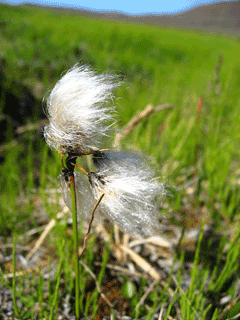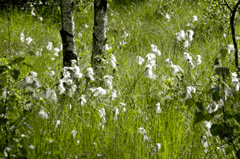 |
|
http://commons.wikimedia.org/wiki/User:Slaunger |
 |
| http://www.commanster.eu/commanster.html |
Translate this page:
Summary
Physical Characteristics

 Eriophorum angustifolium is a PERENNIAL growing to 0.6 m (2ft) by 1 m (3ft 3in).
Eriophorum angustifolium is a PERENNIAL growing to 0.6 m (2ft) by 1 m (3ft 3in).
See above for USDA hardiness. It is hardy to UK zone 4 and is not frost tender. It is in flower from May to June, and the seeds ripen from July to August. The species is monoecious (individual flowers are either male or female, but both sexes can be found on the same plant) and is pollinated by Wind.
Suitable for: light (sandy), medium (loamy) and heavy (clay) soils and can grow in heavy clay soil. Suitable pH: mildly acid soils and can grow in very acid soils.
It can grow in semi-shade (light woodland) or no shade. It prefers wet soil and can grow in water.
UK Hardiness Map
US Hardiness Map
Synonyms
E. polystachion.
Plant Habitats
Pond; Bog Garden;
Edible Uses
Edible Parts: Root Stem
Edible Uses:
Young stem bases - raw or cooked[172]. Usually cooked and eaten with oil[257]. Root - raw or cooked[257]. The blackish covering should be removed[172].
References More on Edible Uses
Medicinal Uses
Plants For A Future can not take any responsibility for any adverse effects from the use of plants. Always seek advice from a professional before using a plant medicinally.
Astringent
The leaves and roots are considerably astringent and have been used in the past as a treatment for diarrhoea[4]. Some native North American Indian tribes would eat the stems raw in order to restore good health to people in generally poor health[257].
References More on Medicinal Uses
The Bookshop: Edible Plant Books
Our Latest books on Perennial Plants For Food Forests and Permaculture Gardens in paperback or digital formats.

Edible Tropical Plants
Food Forest Plants for Hotter Conditions: 250+ Plants For Tropical Food Forests & Permaculture Gardens.
More

Edible Temperate Plants
Plants for Your Food Forest: 500 Plants for Temperate Food Forests & Permaculture Gardens.
More

More Books
PFAF have eight books available in paperback and digital formats. Browse the shop for more information.
Shop Now
Other Uses
Paper Stuffing Tinder Weaving Wick
The cottony seed hairs are used to make candle wicks[4, 13, 100, 172]. They are also used for stuffing pillows[4, 74, 141], paper making etc and as a tinder[74]. Experiments have been made in using the hairs as a cotton substitute, but they are more brittle than cotton and do not bear twisting so well[4]. The dried leaves and stems have been woven into soft mats or covers[257].
Special Uses
References More on Other Uses
Cultivation details
Requires boggy conditions or a pond margin and an acid soil[1, 162]. Grows well in heavy clay soils. Quite invasive.
References Carbon Farming Information and Carbon Sequestration Information
Temperature Converter
Type a value in the Celsius field to convert the value to Fahrenheit:
Fahrenheit:
The PFAF Bookshop
Plants For A Future have a number of books available in paperback and digital form. Book titles include Edible Plants, Edible Perennials, Edible Trees,Edible Shrubs, Woodland Gardening, and Temperate Food Forest Plants. Our new book is Food Forest Plants For Hotter Conditions (Tropical and Sub-Tropical).
Shop Now
Plant Propagation
Seed - sow in situ in spring in a moist soil in light shade. Germination usually takes place within 2 - 6 weeks at 15°c[200]. If the seed is in short supply it can be sown in pots in a cold frame. Place the pots in a try of water to keep the compost moist. When large enough to handle, prick the seedlings out into individual pots and plant them out in the summer. Division in spring or autumn. Very easy, the divisions can be replanted direct into their permanent positions.
Other Names
If available other names are mentioned here
Native Range
TEMPERATE ASIA: Turkey NORTHERN AMERICA: Canada (Northwest Territories, Yukon, Québec, Nova Scotia, Ontario, Prince Edward Island, New Brunswick, Newfoundland and Labrador,Saskatchewan, Alberta, Manitoba, British Columbia), Greenland, United States (Alaska, Indiana, Maine, Michigan, New York, Illinois, Iowa, Minnesota, Nebraska, North Dakota, South Dakota, Wisconsin, Colorado, Idaho, Montana, Oregon, Washington, Wyoming, New Mexico, Utah) EUROPE: Denmark, Finland, United Kingdom, Iceland, Norway, Sweden, Austria, Belgium, Switzerland, Czech Republic, Germany, Hungary, Poland, Slovakia, Albania, Bulgaria, Bosnia and Herzegovina, Greece, Croatia, Italy, Romania, Serbia, Slovenia, Spain, Portugal
Weed Potential
Right plant wrong place. We are currently updating this section.
Please note that a plant may be invasive in one area but may not in your area so it's worth checking.
Conservation Status
IUCN Red List of Threatened Plants Status :

Growth: S = slow M = medium F = fast. Soil: L = light (sandy) M = medium H = heavy (clay). pH: A = acid N = neutral B = basic (alkaline). Shade: F = full shade S = semi-shade N = no shade. Moisture: D = dry M = Moist We = wet Wa = water.
Now available:
Food Forest Plants for Mediterranean Conditions
350+ Perennial Plants For Mediterranean and Drier Food Forests and Permaculture Gardens.
[Paperback and eBook]
This is the third in Plants For A Future's series of plant guides for food forests tailored to
specific climate zones. Following volumes on temperate and tropical ecosystems, this book focuses
on species suited to Mediterranean conditions—regions with hot, dry summers and cool, wet winters,
often facing the added challenge of climate change.
Read More
Expert comment
Author
Honckeny.
Botanical References
17200
Links / References
For a list of references used on this page please go here
Readers comment
| Add a comment |
|
If you have important information about this plant that may help other users please add a comment or link below. Only comments or links that are felt to be directly relevant to a plant will be included. If you think a comment/link or information contained on this page is inaccurate or misleading we would welcome your feedback at [email protected]. If you have questions about a plant please use the Forum on this website as we do not have the resources to answer questions ourselves.
* Please note: the comments by website users are not necessarily those held by PFAF and may give misleading or inaccurate information.
To leave a comment please Register or login here All comments need to be approved so will not appear immediately.
|
Subject : Eriophorum angustifolium
|
|
|
|